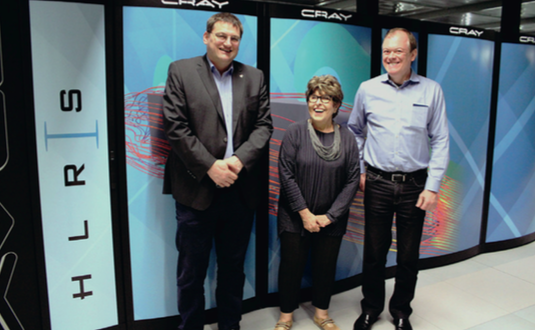High Performance Art: a cooperation inbetween worlds
As part of the cooperation with the Art Institute Itaú Cultural in São Paulo, the Brazilian artist Regina Silveira visited the High Performance Computing Center of Stuttgar in July 2016. Her next art piece will use the computing resources of HLRS and will be presented to the public in May 2017.
At the time of Leonardo da Vinci, it was quite natural that science and art went hand in hand in order to learn and benefit from each other. With the increasing modernization of society, these two sectors have moved apart, only to increasingly converge once again nowadays. The state of Baden-Württemberg has already taken this harmonization into account of the structu- ring of the departments: in the Ministry of Science, Research and Art the mentioned fields are brought together to ensure maximum synergies.
It is one of the declared aims of the Media Solution Center (MSC) to likewise contribute to better links between art and science, which shows already in the compilation of the project partners: In addition to scientific institutions such as the High Performance Computing Center of Stuttgart (HLRS) also the Center for Art and Media Karlsruhe is among the partners. The fact that there is computationally inten- sive art, we know at least since the early days of computer art in the middle of the 60s. Thanks to Frieder Nake, one of the pioneers of computer art, the roots of this field are also located in Stuttgart.
In the winter of 2015 there were first talks with between the MSC and Matt Concept in Stuttgart. The company acts as a mediator and consultant in the field of art. With their help the contact with the Art Ins- titute Itaú Cultural in São Paulo was established. It quickly became clear that both sides are interested in a joint project:
For the planned cooperation, the internationally renowned artist Regina Silveira joinned in. Since the 50s she has been active in the art scene and can now look back on an impres- sive exposé. With the tackled topics also the media she uses have changed over the years. While she used traditi- onal forms like painting in her early art, now also digital drawings, printings and video elements have found their way into her work. In the recent past, her focus was on large-scale wrappings of buildings and walls, which distributed her recurring motives all across the globe. In Germany she had installations in Munich, Frankfurt and Karlsruhe. Well-kown museums like the Museum of Modern Art in New York, the Museo de Arte Moderna de São Paulo and the Taipei Fine Arts Museum in Taiwan included her works in their permanent exhibitions.
What luck that Ms. Silveira despite her diverse projects and commitments could find the time to visit the HLRS for a week. The technical director of the cooperation project, Dr. Marcos Cuzziol from Itaú Cultural accompanied her. During this week, there was the opportunity for the artist and the scientists of HLRS to exchange ideas and to give each other an insight in their specific work worlds. Of course there weren’t only conversations about the technical infrastructur, but also the opportunity for a more direct experience: during a tour of the Hazelhen computer room and a detailed CAVE demo, which is a 3D visualisation lab, the comprehensive technical possibilities were presented.
The finished art object, which will be the result from this cooperation by using the HPC infrastructure of the HLRS, premieres in May 2017 at Itaú Cultural and shall be shown later aswell in Stuttgart.
Annekatrin Baumann
Projektkoordination Media Solution Center
HLRS
Media Solution Center

Prof. Michael Resch (Direktor des HLRS), Regina Silveira and Dr. Marcos Cuzziol
Supercomputer „Hazelhen“